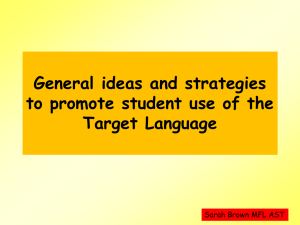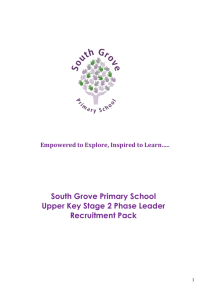KS2-3 Transition Follow up 1
advertisement
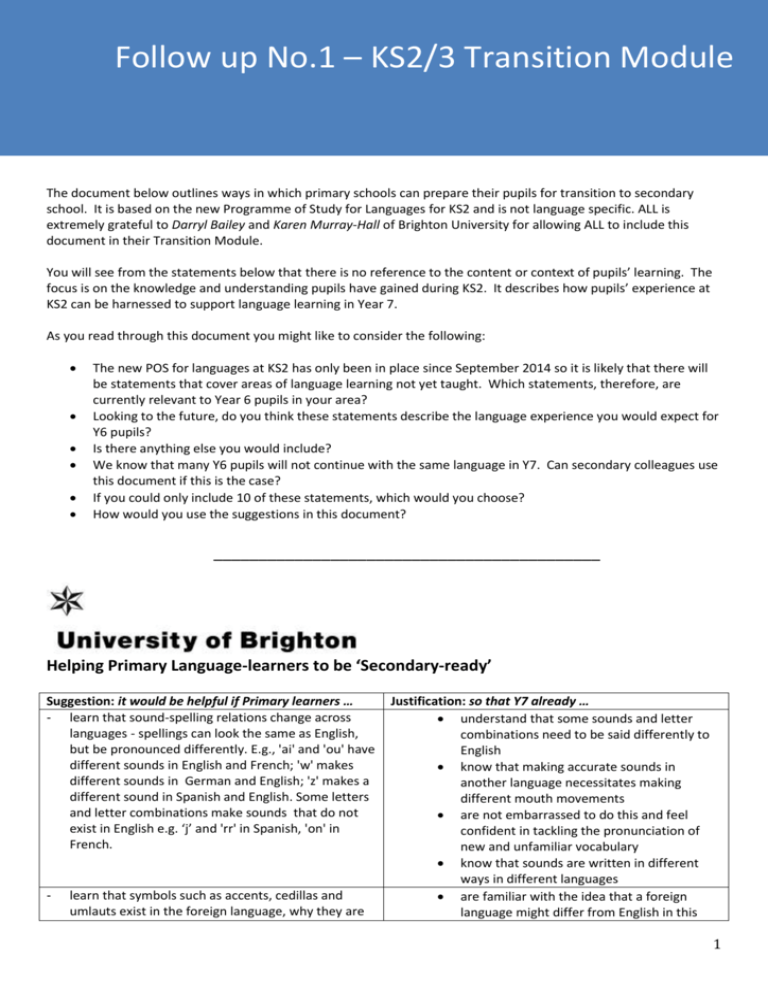
Follow up No.1 – KS2/3 Transition Module The document below outlines ways in which primary schools can prepare their pupils for transition to secondary school. It is based on the new Programme of Study for Languages for KS2 and is not language specific. ALL is extremely grateful to Darryl Bailey and Karen Murray-Hall of Brighton University for allowing ALL to include this document in their Transition Module. You will see from the statements below that there is no reference to the content or context of pupils’ learning. The focus is on the knowledge and understanding pupils have gained during KS2. It describes how pupils’ experience at KS2 can be harnessed to support language learning in Year 7. As you read through this document you might like to consider the following: The new POS for languages at KS2 has only been in place since September 2014 so it is likely that there will be statements that cover areas of language learning not yet taught. Which statements, therefore, are currently relevant to Year 6 pupils in your area? Looking to the future, do you think these statements describe the language experience you would expect for Y6 pupils? Is there anything else you would include? We know that many Y6 pupils will not continue with the same language in Y7. Can secondary colleagues use this document if this is the case? If you could only include 10 of these statements, which would you choose? How would you use the suggestions in this document? ___________________________________________ Helping Primary Language-learners to be ‘Secondary-ready’ Suggestion: it would be helpful if Primary learners … - learn that sound-spelling relations change across languages - spellings can look the same as English, but be pronounced differently. E.g., 'ai' and 'ou' have different sounds in English and French; 'w' makes different sounds in German and English; 'z' makes a different sound in Spanish and English. Some letters and letter combinations make sounds that do not exist in English e.g. ‘j’ and 'rr' in Spanish, 'on' in French. - learn that symbols such as accents, cedillas and umlauts exist in the foreign language, why they are Justification: so that Y7 already … understand that some sounds and letter combinations need to be said differently to English know that making accurate sounds in another language necessitates making different mouth movements are not embarrassed to do this and feel confident in tackling the pronunciation of new and unfamiliar vocabulary know that sounds are written in different ways in different languages are familiar with the idea that a foreign language might differ from English in this 1 used and what they do - have seen, heard and said the alphabet in a foreign language. Practise spelling their name in a foreign language. - - - - - are used to talking about English and a foreign language using simple grammatical terms such as nouns, verbs, adjectives, adverbs, pronouns and connectives/conjunctions recognize that word order is different in different languages (e.g. adjectives before or after a noun), and understand that word order changes the meaning of sentences e.g. to make a question or a negative. experience working with a bilingual dictionary, know what it is, how it is constructed, what it contains, and how to use it effectively to support learning the language and about the language understand that online dictionaries, translator websites and Apps may not be trusted to translate accurately, why this is the case and what language problems can be caused as a result have heard and understand the term ‘cognate’ and ‘near-cognate’ and use knowledge of these to work out meanings - practice using strategies to help them when language is difficult such as using other words and the situation to guess meanings; looking at the end of words to work out meaning e.g., gender, singular/plural, tense, case Suggestion: it would be helpful if Primary learners … - know where at least one foreign language is spoken around the world and some facts about the culture, people, and places - know why it is good to learn a language other than English - - - way understand the role of these symbols recognise that the vowel and consonant sounds of a foreign language may sound similar or different to English are not embarrassed to do this and feel confident in tackling the pronunciation of new and unfamiliar vocabulary understand that these terms are useful for learning a new language understand that words are arranged in different ways in different languages and that this can affect the meaning of a sentence know how to find new words in a foreign language by using a bilingual dictionary effectively know how to use online sources effectively to support their learning understand this terminology and feel confident in using it to discuss vocabulary in a foreign language be able to use these strategies to help learn other languages Justification: so that Y7 already … understand that learning a language also involves learning about its context in the world understand and appreciate the value of learning a foreign language have heard the term ‘gender of nouns’ and ‘adjectival agreement’, can talk about what this means, and understand that English can be seen as the ‘odd one out’ compared to many European languages such as, eg, French, Spanish, German and Italian. have seen a few verb tables, compared these to the English layout of the same verb, noticed and discussed any patterns understand that nouns having a gender is a normal idea in lots of other languages and is important in trying to learn and speak a foreign language accurately know that verb tables exist and be able to talk about why they might be useful to look at when learning a language have heard the word ‘tenses’ used in connection with verbs, noticed how the verb endings may differ in some examples and compared these with the English versions understand that verb endings can change, in both English and a foreign language, when talking about the present, past or the future 2 have some experience of listening to spoken language for specific items such as a particular word, phrase or phoneme have experience of reading a few simple phrases and understanding particular words, phrases and meanings. have some experience of looking for specific items such as a particular word or phrase, capital letters, specific phoneme, same pronoun, etc., in a variety of foreign language texts (eg, story, song, weather report, newspaper article, letter, post card) have lots of experience of talking in the foreign language to each other, even if with very little language are familiar with listening to spoken foreign language for details and gist are familiar with reading a foreign language for details and gist are familiar with the idea of skimming and scanning text to find details are familiar with the idea of role-play conversations as a language-learning strategy - have used peer and self-assessment strategies to support language learning feel confident in knowing how to talk positively about own progress and how to help peers - have been exposed to the foreign language being used in peripheral and incidental ways during their school life (for instructions, praise, questions, comments, greetings), including during language lessons are familiar with the ‘target language’ being used in lessons are familiar with the idea of being able to respond or speak the foreign language spontaneously - know and describe some strategies which help to remember key words and phrases know some strategies for memorising new vocabulary in a foreign language - have had some practice in using scaffolded phrases and sentences to create their own, using a variety of resources such as text cards, vocabulary lists and dictionaries to help them replace words feel confident in knowing how to use some resources to support creativity and independence in using the foreign language - - - - Daryl Bailey and Karen Murray-Hall, University of Brighton 3
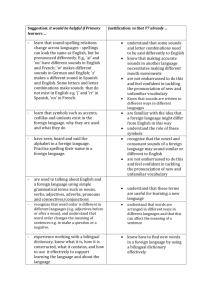
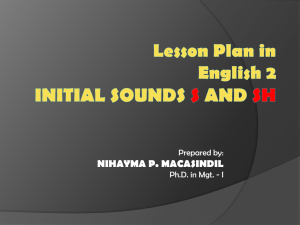
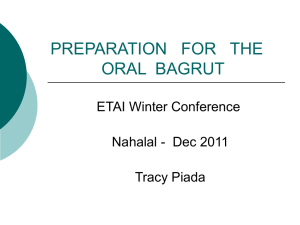
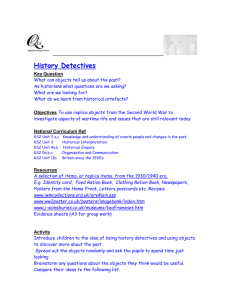


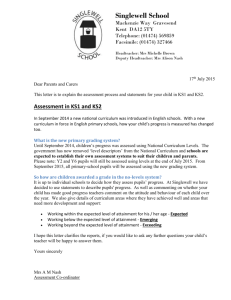
![afl_mat[1]](http://s2.studylib.net/store/data/005387843_1-8371eaaba182de7da429cb4369cd28fc-300x300.png)

